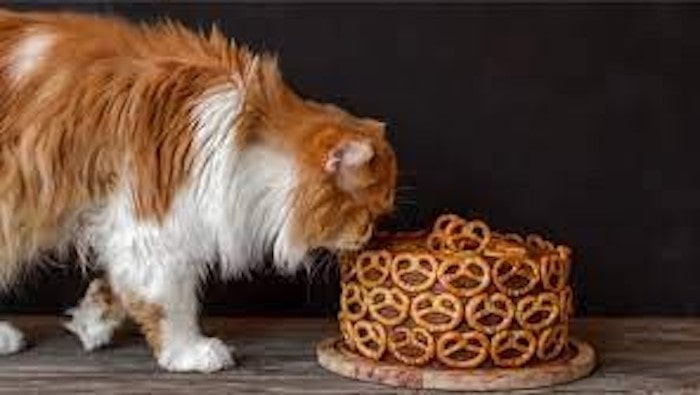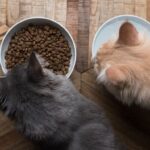As responsible pet owners, it’s essential to ensure our beloved feline friends are provided with a safe and healthy diet. While cats may often exhibit a curiosity for our human snacks, it’s important to understand which foods are suitable for their consumption.
In this article, we will delve into the world of pretzels and their potential impact on our furry companions. Join us as we unravel the truth behind this crunchy treat and shed light on whether our feline friends can safely enjoy pretzels as a snack.
So, let’s embark on this intriguing journey and discover if pretzels are just a twisty delight for humans or if they can be shared with our whiskered companions as well.
What are Pretzels?
A pretzel is a type of baked pastry made from dough that is commonly shaped into a knot. The original pretzel shape is symmetrical, with the ends of a long strip of dough interlaced and twisted back on itself in a specific way. Pretzels are now available in a variety of shapes.
The most frequent seasoning for pretzels is salt, which works in tandem with the washing soda or lye treatment that gives pretzels their traditional skin and flavor thanks to the Maillard reaction. Mustard, cheeses, sugar, chocolate, cinnamon, sweet glaze, seeds, and nuts are some of the other ingredients.
Soft pretzels, which should be eaten right away after preparation, and hard-baked pretzels, which have a longer shelf life, are two types of pretzels.
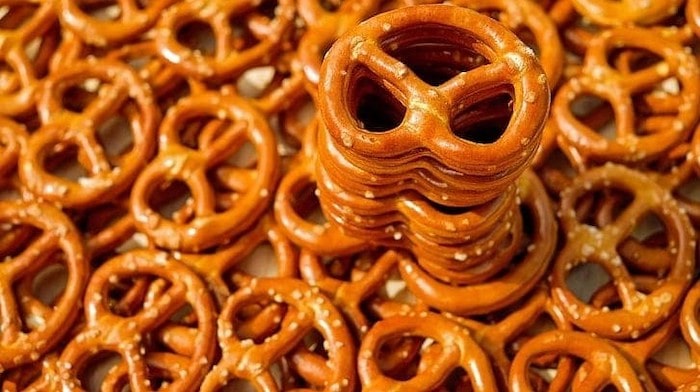
Southern German and Swiss German immigrants brought the pretzel to North America in the late 1800s. The immigrants became known as the Pennsylvania Dutch, and as the pretzel’s popularity grew, so did the number of handcrafted pretzel bakeries that dotted the central Pennsylvania countryside.
Soft pretzels grew popular in different parts of the United States over the twentieth century. Soft pretzels were famous in cities like Philadelphia, Chicago, and New York.
The introduction of new industrialized-era mass production methods, which increased availability and quantity, as well as the opening of multiple points of distribution at schools, convenience and grocery stores, and entertainment venues such as movie theaters, arenas, concert halls, and sports stadiums, were critical to success.
Are Pretzels Safe for Cats to Eat?
The main answer is: yes, but only in moderation.
The reasons why pretzels are mostly okay for cats to eat are:
- Wheat flour, water, yeast, shortening, and salt are not toxic for cats
- Grains can provide some vitamins and energy for cats
- Salt can stimulate cats’ thirst and water intake
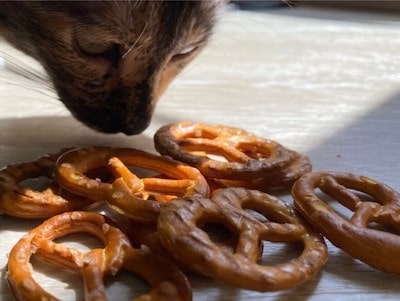
However, there are also some potential risks of feeding pretzels to cats:
- Overfeeding can cause obesity, diabetes, or digestive issues
- Some seasonings like garlic, onion, chocolate, or xylitol can be harmful or fatal for cats
- Choking hazards from large or hard pieces of pretzels
Let’s take a closer look at each of these points.
Wheat Flour
Wheat flour is the main ingredient in most pretzels. It is a source of carbohydrates, which provide energy for cats. Carbohydrates are one of the three categories of macronutrients, alongside fats and protein, included in diets for animals.
Cats are carnivores and need to eat a lot of protein in comparison to many other animals. Dietary protein is used to develop and maintain muscle, skin, fur, nails, tendons, ligaments, cartilage, enzymes, hormones, antibodies, and more. In cats, protein is also an important source of energy.
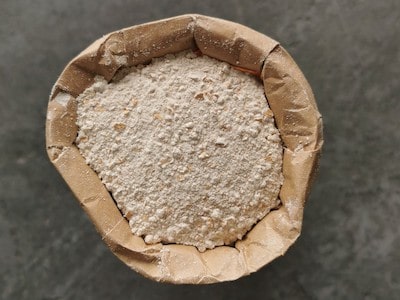
Dr. Deb Zoran, a professor at the Texas A&M College says that, “Canned food with a protein content of at least 40% and a carbohydrate content of at most 10% is the best method to approximate a cat’s normal diet.”
However, this does not mean that cats cannot digest carbohydrates at all. Cats can digest processed grains using the enzymes that are normally present in their digestive system: amylase for the starches and proteases for the proteins.
Wheat flour also contains some essential nutrients for cats such as vitamin E (which protects against cell oxidation), B vitamins (which provide a range of benefits for the nervous system, skin, hair, and growth), linoleic acid (an essential fatty acid), fiber (which supports healthy gastrointestinal function), and easily digestible protein.
Salt
Salt is another common ingredient in pretzels. It adds flavor and texture to the snack. Salt also works in tandem with the washing soda or lye treatment that gives pretzels their traditional skin and flavor thanks to the Maillard reaction.
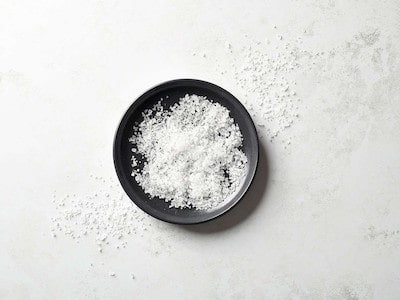
Some cat owners might be concerned with giving their cats too much salt if they feed them pretzels[1]. Though high levels of sodium in the bloodstream can be fatal for cats with cardiovascular or kidney disease, consuming enough salt to cause damage would be nearly impossible for a cat. Even in a study where a cat was given 3 times more than the daily recommended amount for over two years, no adverse effects were present.
So, watching your cat’s sodium intake is not so necessary after all. In fact, it may be better for her to eat some salty snacks in order to trigger her thirst for more water. Cats are notoriously bad at drinking enough water to maintain healthy urinary tracts, so eating salt can increase their thirst and water intake, staving off UTI’s.
Seasonings
Some pretzels contain seasonings like garlic or onion powder, which even in powder form can be distressing to a cat’s digestive system and should be avoided. Garlic and onion contain compounds called thiosulfates, which can damage red blood cells and cause anemia in cats. Symptoms of garlic or onion toxicity[2] include weakness, lethargy, pale gums, rapid breathing, vomiting, diarrhea, and collapse.
Other seasonings that can be harmful or fatal for cats include chocolate and xylitol. Chocolate contains caffeine and theobromine, which are stimulants that can affect the heart and nervous system of cats.
Symptoms of chocolate toxicity include restlessness, hyperactivity, tremors, seizures, abnormal heart rhythm, and death. Xylitol is a sugar substitute that can cause a sudden drop in blood sugar and liver failure in cats. Symptoms of xylitol toxicity include vomiting, weakness, depression, loss of coordination, and seizures.
Therefore, it is important to check the ingredients list before feeding your cat any pretzels. Avoid pretzels with toxic or unhealthy seasonings and opt for plain or lightly salted ones instead.
Choking Hazards
Another risk of feeding pretzels to cats is choking. Cats have small mouths and throats, which can make it difficult for them to swallow large or hard pieces of food. Pretzels can be crunchy and brittle, especially the hard-baked ones, which can pose a choking hazard for cats.
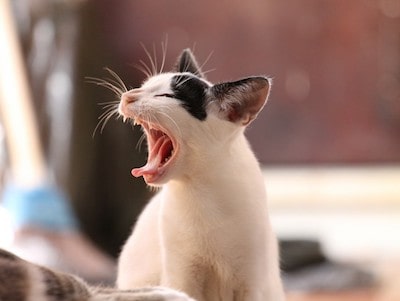
To prevent choking, break pretzels into small pieces or choose soft ones that are easier to chew and swallow. You can also moisten pretzels with water or broth to make them softer and more palatable for your cat.
“If you have a cat that eats quickly and doesn’t chew their food before swallowing, it may be helpful to feed smaller, more frequent meals or use a slow feeder to help minimize the possibility of choking”, suggests Jamie Case, DVM from PetMD
What are the Things to Keep in Mind Before Feeding Pretzels to Your Cat?
Here are some tips on how to feed pretzels to your cat safely and moderately:
- Avoid overfeeding: limit pretzels to no more than 5–10% of your cat’s diet, according to WebMD. Pretzels should not replace your cat’s regular food, but only serve as an occasional treat. Overfeeding pretzels can cause obesity, diabetes, or digestive issues in cats.
- Always check the ingredients: avoid pretzels with toxic or unhealthy seasonings like garlic, onion, chocolate, or xylitol. Opt for plain or lightly salted ones instead.
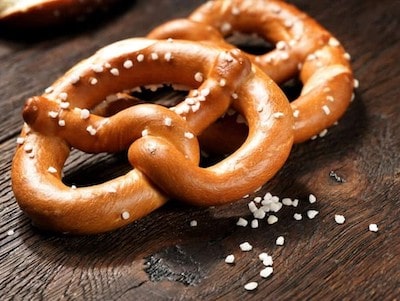
- Keep an eye out for choking hazards: break pretzels into small pieces or choose soft ones that are easier to chew and swallow. You can also moisten pretzels with water or broth to make them softer and more palatable for your cat.
- Always choose healthy alternatives: offer your cat some natural treats like meat, fish, cheese, or fruits that are more suitable for their carnivorous nature and nutritional needs. You can also look for cat treats that are specially formulated to provide balanced nutrition and dental benefits for your cat.
Can Cats Eat Flavored Pretzel Sticks?
Flavored pretzel sticks are another type of pretzel that you might find in the market. They are usually thin and long, with various flavors added to them. Some common flavors are cheese, peanut butter, honey mustard, barbecue, sour cream and onion, and cinnamon sugar.
Can cats eat flavored pretzel sticks? The answer is: it depends on the flavor and the ingredients.

Some flavors are safe for cats to eat, such as cheese or peanut butter, as long as they do not contain any toxic or unhealthy ingredients like garlic, onion, chocolate, or xylitol. Cheese and peanut butter can provide some protein and calcium for cats, but they should be given in moderation as they are also high in fat and calories.
Other flavors are unsafe for cats to eat, such as honey mustard, barbecue, sour cream and onion, and cinnamon sugar. These flavors contain ingredients that can be harmful or fatal for cats, such as garlic, onion, vinegar, sugar, spices, and artificial sweeteners. These ingredients can cause digestive upset, anemia, liver failure, or even death in cats.
Therefore, before feeding your cat any flavored pretzel sticks, make sure to check the ingredients list carefully and avoid any flavors that contain toxic or unhealthy ingredients for cats. Better yet, stick to plain or lightly salted pretzel sticks instead.
Can Kittens Eat Pretzels?
Kittens are young cats that are still growing and developing their bodies and immune systems. They have different nutritional needs than adult cats and require more protein, fat, calories, vitamins, minerals, and amino acids in their diet.
Can kittens eat pretzels? The answer is: no, it is not recommended.
The reasons why kittens should not eat pretzels are:
- Kittens need a high-quality kitten food that is specially formulated to meet their nutritional needs. Pretzels do not provide enough protein, fat, calories, vitamins, minerals, and amino acids for kittens.
- Kittens are more sensitive to new foods and allergens than adult cats. Feeding them pretzels can cause digestive upset, diarrhea, vomiting, or allergic reactions in kittens.
- Kittens are more prone to choking on hard or large pieces of pretzels than adult cats. Their mouths and throats are smaller and more delicate, which can make it difficult for them to swallow pretzels safely.
Therefore, it is best to avoid feeding pretzels to kittens and only offer them a high-quality kitten food that is specially formulated to meet their nutritional needs. You can also consult your veterinarian for more advice on what to feed your kitten.
FAQ
How many pretzels can I feed my cat?
There is no definitive answer to this question, as different cats may have different tolerances and preferences for pretzels. However, a general rule of thumb is to limit pretzels to no more than 5–10% of your cat’s diet, according to WebMD. This means that you can feed your cat a few small pieces of pretzels as an occasional treat, but not as a regular food or a meal replacement.
Is the salt presence in pretzels safe for cats?
Yes, the salt presence in pretzels is generally safe for cats, as long as they do not have any underlying health conditions that require a low-sodium diet, such as cardiovascular or kidney disease. Cats can tolerate moderate amounts of salt in their diet, and salt can even stimulate their thirst and water intake, which can help prevent urinary tract infections. However, too much salt can cause dehydration, high blood pressure, or sodium poisoning in cats, so it is important to not overfeed pretzels to your cat.
Do cats like salted pretzels?
Some cats may like salted pretzels, while others may not. Cats have different taste preferences and palates than humans, and they may not enjoy the same foods that we do. Cats also have fewer taste buds than humans, and they cannot taste sweet flavors at all. Therefore, they may not find salted pretzels as appealing or satisfying as we do. However, some cats may be curious or attracted to the smell or texture of salted pretzels, and they may want to try them out of curiosity or boredom.
Final Thoughts
Pretzels are a popular snack for humans, but they are not an ideal food for cats. Cats can eat pretzels in moderation, as long as they do not contain any toxic or unhealthy ingredients for cats, such as garlic, onion, chocolate, or xylitol. Pretzels can provide some carbohydrates, fiber, vitamins, minerals, and protein for cats, but they are also high in calories, fat, and salt, which can cause obesity, diabetes, or digestive issues in cats if overfed.
Therefore, it is best to limit pretzels to no more than 5–10% of your cat’s diet and only offer them as an occasional treat. You should also check the ingredients list before feeding your cat any pretzels and avoid any flavors that contain toxic or unhealthy ingredients for cats. You should also break pretzels into small pieces or choose soft ones that are easier to chew and swallow for your cat.
If you want to give your cat a healthy and balanced diet that meets their nutritional needs and preferences, you should choose a high-quality cat food that is specially formulated for cats. You can also consult your veterinarian for more advice on what to feed your cat.
Reference:
- Coates, J., DVM. (2015, December 9). Is Too Much Salt Dangerous for Cats? www.petmd.com. Retrieved July 28, 2023. PetMD
- Salgado, B. S., Monteiro, L. N., & Rocha, N. S. (2011). Allium species poisoning in dogs and cats. Journal of Venomous Animals and Toxins Including Tropical Diseases, 17(1), 4–11. SciELO

